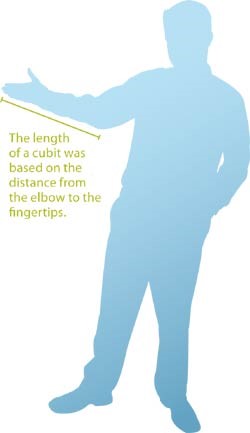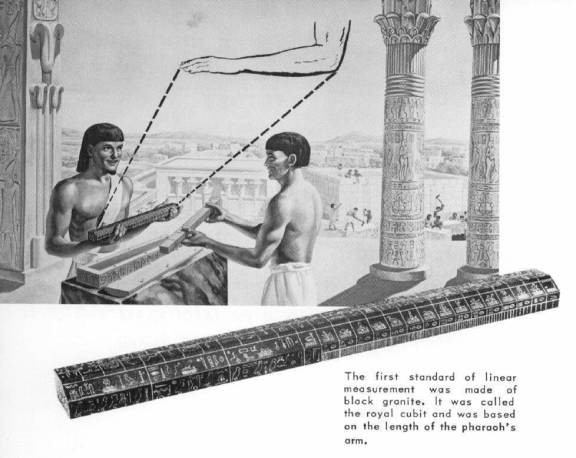 Cubits are a little less familiar than another related measure we still use today, the foot. The foot is a measure based on the length of an average man’s foot. The cubit, similarly, is a measure based on the distance from elbow to fingertip.
Cubits are a little less familiar than another related measure we still use today, the foot. The foot is a measure based on the length of an average man’s foot. The cubit, similarly, is a measure based on the distance from elbow to fingertip.
Although it is speculated that there was one standard cubit measure at the time of Noah’s ark, since that time different civilizations have selected slightly varying standards for the length of a cubit.
We know some of these lengths because of artifacts such as measuring tools that archaeologists have uncovered. Other ancient measures we know through comparison of in-tact buildings to written descriptions by ancient writers. Other times it’s little more than an educated guess.
Varying Cubit Standards
| Culture | Inches (cm) |
|---|---|
| Hebrew (short) | 17.5 (44.5) |
| Egyptian | 17.6 (44.7) |
| Common (short) | 18 (45.7) |
| Babylonian (long) | 19.8 (50.3) |
| Hebrew (long) | 20.4 (51.8) |
| Egyptian (long) | 20.6 (52.3) |
(credit: Bodie Hodge)
In Egypt, there were two different cubit lengths used, the Standard Cubit, and the Royal Cubit. Some say the Royal Egyptian Cubit was based on the length of the Pharaoh’s arm. Others think it is longer than the standard cubit because Pharaoh considered himself greater than other men. In either case, a master copy of this measure was carved into a block of granite. Those building tombs, temples, and pyramids had to monthly re-calibrate measuring sticks against their royal standard; failure to re-calibrate was punishable by death!
So which Cubit was Moses using?
Considering Moses was raised in the palace of Pharaoh, he was probably well acquainted with the royal measure (20.5″). Other Israelites who were part of the Exodus had previously been builders for Pharaoh as well. It would seem pretty logical that the craftsmen building the tabernacle had personal experience with building in Royal Cubits. And likely some of the valuable items they plundered from the Egyptians before the Exodus may have been sized according to Royal Cubits.
Interestingly, one royal cubit cubed (3d) is almost exactly the volume required to make 50 talents of silver.
Of course, not everyone agrees which cubit is right, but 18-22 inches are most common cubit conversions, leaving a plus or minus 10% range of error if using a standard Royal Cubit.
Download PDF version of this article

